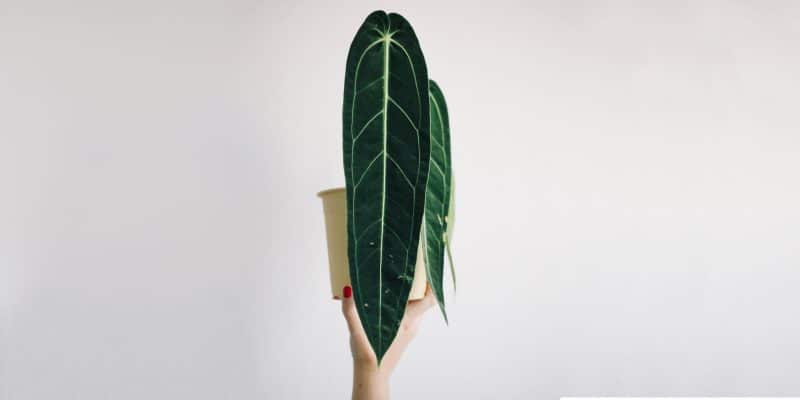Ready to meet a royal beauty that’ll sweep you off your feet? Well, look no further than the Queen Anthurium (Anthurium warocqueanum). This stunning tropical plant is an absolute show-stopper, featuring majestic, velvety dark green leaves with mesmerizing silvery-white veins.
Talk about a head-turner!
Queen Anthurium is not your everyday houseplant — she’s a rare gem that hails from the rainforests of Central and South America (so you know she’s got that exotic appeal). But what really sets this queen apart?
It’s her impressive size and love for high humidity environments that makes her truly stand out. The Queen has a way of making her presence known, and she’ll demand your full attention.
Now, don’t worry, taking care of royalty isn’t as daunting as it sounds. Sure, she might be a bit sensitive and require some extra care, but hey, who doesn’t, right?
To help you on this botanical adventure, we’ve put together a handy guide that’ll teach you everything you need to know about Anthurium warocqueanum care. From mastering propagation to tackling common issues, we’ll have you feeling like a true plant-whisperer in no time.
So, how about it? Are you ready to embrace the challenge and welcome this regal beauty into your home?
Table of Contents
Anthurium Warocqueanum Plant Care Guide
History, Habitat, and Characteristics
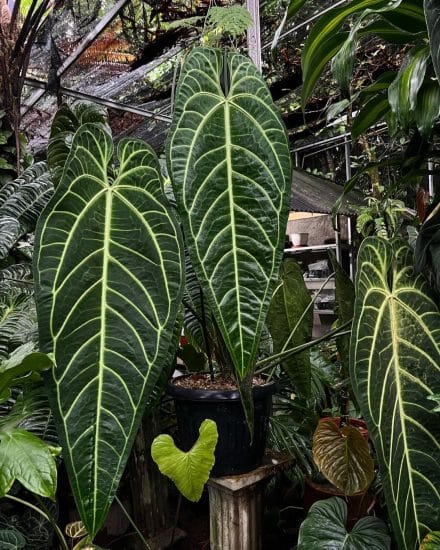
Have you met the Queen Anthurium (Anthurium warocqueanum) yet? If not, let us introduce you to this jaw-dropping houseplant that’s stealing the hearts of plant lovers everywhere.
Originating from the lush tropical rainforests of Central and South America, this highly coveted ornamental plant species knows how to command attention.
What makes the Anthurium warocqueanum plant so awe-inspiring? Well, it’s all about those big, velvety, dark green leaves with eye-catching silvery-white veins. In optimal conditions, they can even grow up to 6 feet in length!
Queen Anthuriums do produce flowers, although their floral display isn’t as showy or eye-catching as some other anthurium varieties. The flowers of Anthurium warocqueanum are typically small, inconspicuous, and usually hidden by the plant’s large, dark green leaves.
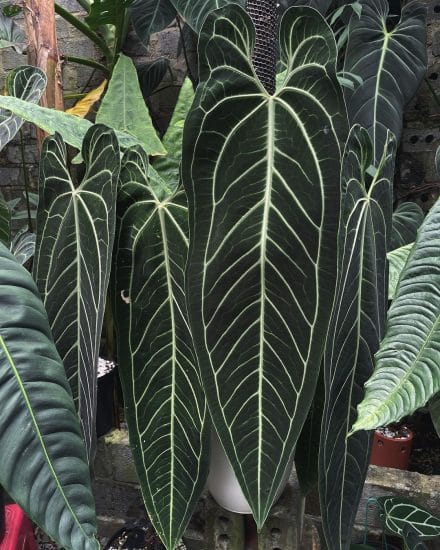
The flower itself consists of a pale green, slender spadix (a spike-like structure) surrounded by a green or maroon spathe. While receiving blooms from your Queen Anthurium is a delightful surprise, it’s truly the magnificent foliage that steals the show and captures the hearts of plant lovers everywhere.
With its fascinating history and unique characteristics, it’s no wonder this royal gem continues to enchant and captivate all who come across it. Bring on the regal vibes!
What’s the difference between Queen Anthurium vs King Anthurium?
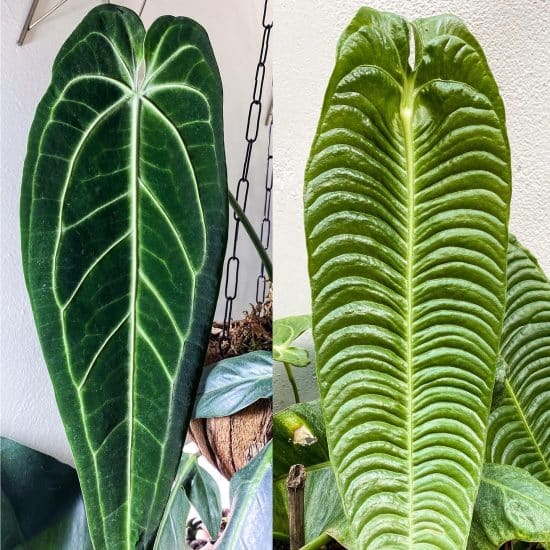
Queen Anthuriums are known for their large, velvety dark green leaves with striking silvery-white veins. They generally have elongated, narrow leaves that grow slightly larger.
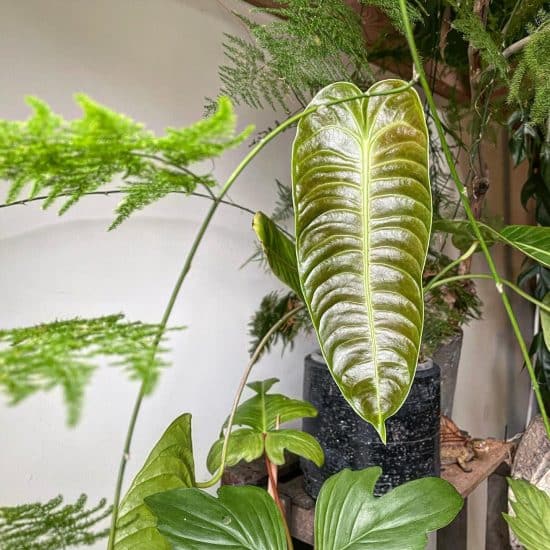
King Anthurium have long, pendulous leaves with a pleated texture and a prominent ribbed pattern on their surface. These leaves can also grow quite large, measuring up to 5 feet long and 3 feet wide.
Both plants require very similar care, such as high humidity and well-draining soil, but it’s their distinct leaf characteristics that set them apart.
Light
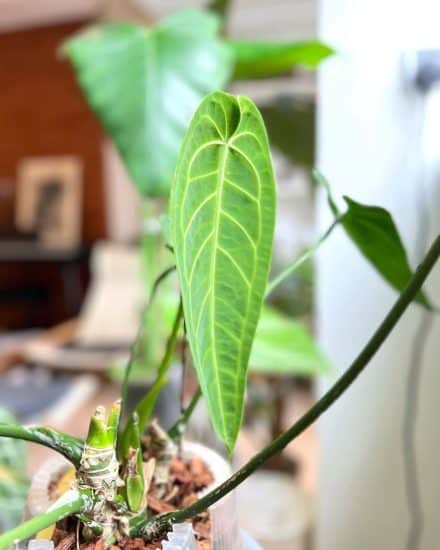
First, let’s take a step back and think about where these gorgeous anthurium species come from…the tropical rainforests of Colombia. And what do they love in their natural habitat? Lots of indirect light filtered through the canopy of trees.
So, what does this mean for growing Anthurium warocqueanum in your home? Simply put, you’ll want to recreate those conditions for your Queen Anthurium care.
Keep an eye out for signs like slow growth, smaller leaves than usual, or a plant that seems to be stretching toward the light (we all know that feeling, don’t we?). If any of these sound familiar, it might be time to move your plant to a brighter spot or even introduce some grow lights.
But how can you tell that your plant is basking in a bit too much light? If your Queen Anthurium warocqueanum gets too much sun, its regal leaves might end up with burns or brown spots and growth may even slow significantly.
Before making any large adjustments, we really recommend taking it slow with this plant. Make small changes, and keep an eye on how your plant responds.
Water
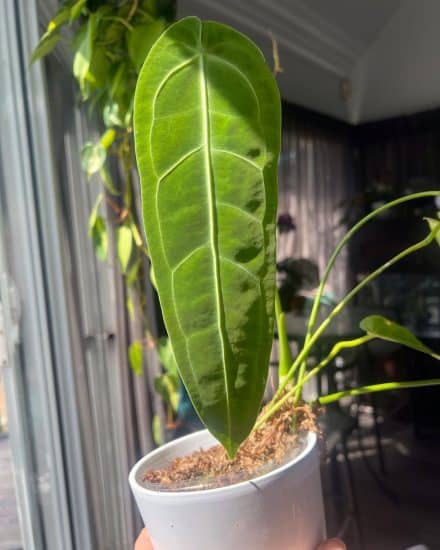
The basis of a water plan is to really pay attention to the amount of light and growth your plant is experiencing.
With the Queen Anthurium warocqueanum, that typically means a good soaking once a week. If you’re using a moss pole, you’ll want to keep that misted and moist in between waterings.
Generally, we want to pay less attention to rigid plans and more to what the plant and soil are telling us. Dry soil a few inches deep? Time to water.
If your Anthurium warocqueanum isn’t getting enough water, you’ll notice wilting leaves, curled-up edges, and even browning. Don’t worry, just increase the watering frequency, maintaining that magical moist-but-not-swampy vibe.
(And hey, do your plant a favor and remove any sad-looking leaves to keep pests away.)
Too much water will look like yellowing leaves, rot, and droopy stems. If this happens, cut back on the waterworks and make sure the soil dries out a bit before your next watering session.
In some cases, you might even need to switch up the soil mixture for better drainage. We’ll cover this a bit later.
Temperature and humidity
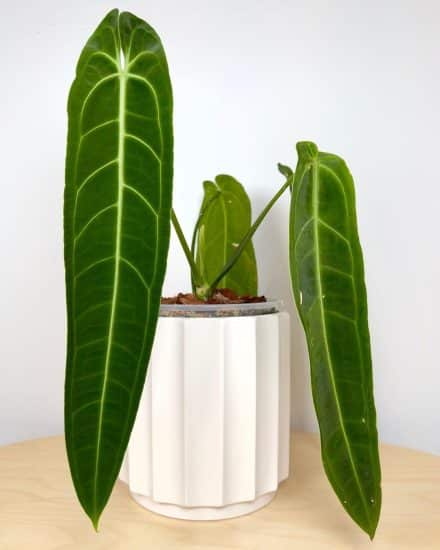
To keep your Anthurium warocqueanum healthy and happy, you’ll want to create an environment that closely resembles its natural tropical habitat.
Anthurium warocqueanum plants are best suited for warm temperatures indoors, ranging from 65-80 degrees Fahrenheit (18-27 degrees Celsius). Keep in mind that they can be sensitive to temperature fluctuations, so avoiding cold drafts and extreme temperature changes is essential for their well-being.
If you notice that the leaves are wilting or turning yellow, it could be a sign that the temperature is either too high or too low.
Although Anthurium warocqueanum can grow well in 50-60% humidity, it will truly thrive in a high humidity of over 80%!
In most climates, that’s going to mean using a greenhouse cabinet or terrarium to really maintain that humidity level. If you notice browning or crisping of the leaves, it could be an indication of insufficient humidity.
If if you do go the greenhouse cabinet route, you’ll want to pay attention to air circulation and consider adding a fan to prevent any fungal/bacterial issues. If not, it’s very likely you’ll need a humidifier.
Soil and planting
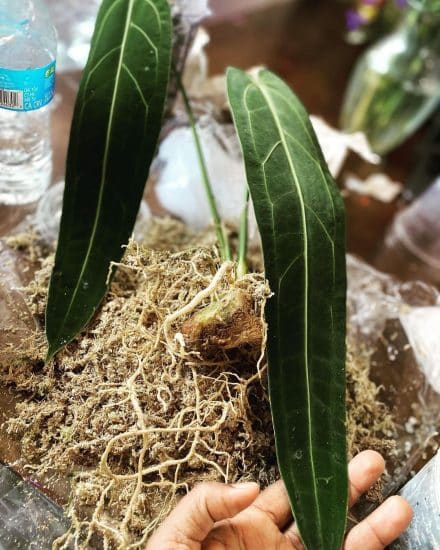
Anthurium warocqueanum thrives in a well-draining, moisture-retaining soil mix. A combination of sphagnum moss, perlite, coco coir, and a small amount of sand can create the perfect balance for this beautiful houseplant.
If you prefer, you can also use a terracotta pot, as this material allow excess moisture to escape, preventing rot. Note that ceramic pots may hold too much moisture and are not recommended for your Anthurium plants.
Signs of getting the soil composition wrong include yellowing leaves, slow growth, and wilting, even with regular watering. If your plant experiences these symptoms, consider repotting it in a more suitable soil mix like an aroid mix to ensure better water retention and drainage.
Fertilizer
We recommend regular (every 2-3 months at first) application of a liquid-balanced fertilizer. Over time, as you calibrate your Anthurium warocqueanum care, you can increase the frequency — just start slowly and heavily diluted to encourage growth.
Too much fertilizer will look like burnt leaves, browning leaf tips, and salty soil. If you notice this, pull back from the quantity and frequency and check that you’re using the right amount for your Anthurium plants.
Consider flushing the soil with fresh water to help remove excess fertilizer buildup.
Propagation Guide
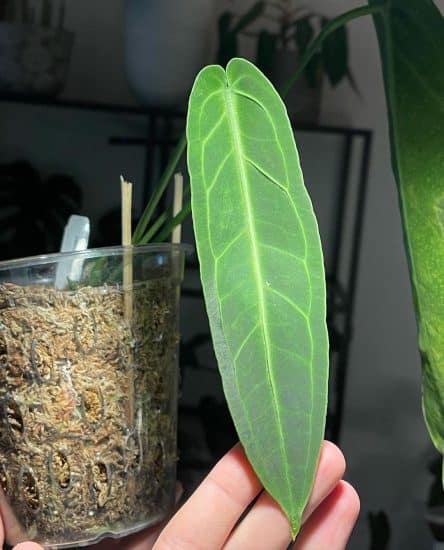
If, like us, you’re in love with your Queen anthurium and want to bring more of its royal beauty into the world, it’s time to think about propagation.
Since these plants are rare and pretty valuable, we really suggest learning about how to propagate them so that you can spread the wealth.
Propagating Anthurium warocqueanum with air layering:
- Prepare your Queen Anthurium by air layering with sphagnum moss wrapped around its stems. You’ll wrap the stems with moss and keep it on the plant with some plastic cling wrap.Air-layering is how we can encourage root development before making cuts, really activating those dormant nodes. You’ll see roots growing into the moss and then into the soil. You’ll want to time things so that it’s not actively pushing out new leaves, to keep stress minimal on that mother plant.
- Now you’ll unwrap the plant and see some significant roots. Our plan is to make a few cuts through the stem. You’re going to find the nodes and auxiliary buds, where new growth will come from. We’re going to cut this stem into chunks, the top chunk containing the existing mature plant and its leaves, the lower chunks each having a few nodes on the stem (a few inches long works great), and some newly encouraged roots coming off.
- Prepare your soil: an aroid mix with sphagnum moss, perlite, coco coir, and some silt will give you a well-draining soil with enough moisture retention for these baby plants.
- Your mother plant can be repotted normally in soil. Your new cuttings will be placed just on top, horizontally on the soil.
- Keep your new cutting in very high humidity in a plastic prop box, or you can make your own with Tupperware or a clear plastic bag over the container. Water thoroughly and keep that humidity high!
We know it can be super scary to take a stem cutting from your Anthurium plant… these things are pricy. We are putting together a full video on this process, but air-layering is really the best way to propagate an epiphytic plant indoors like this, since it leaves a lot less to chance.
Common Issues
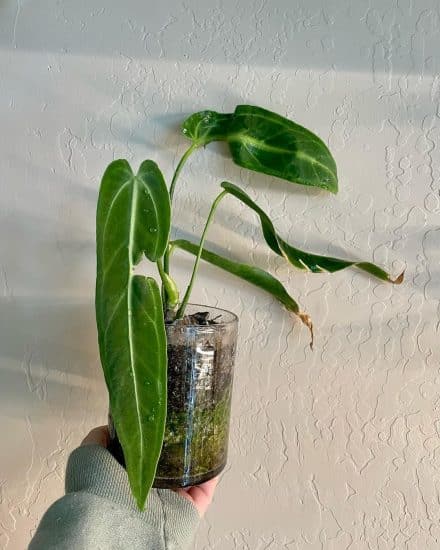
Let’s have a chat about the problems we see most often with these plants.
Brown Crispy Leaf Tips
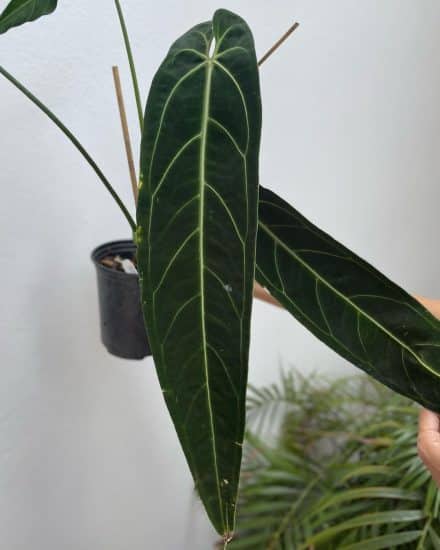
First up, those pesky brown, crispy leaf tips. You know, the ones that make your Queen Anthurium look a little less… regal. This issue could be due to low humidity or inconsistent watering.
Some browning is normal, though (like the plant showing off its life story or maybe a testament to your learning journey as a tropical plant owner).
Make sure your royal highness enjoys a humid environment, around 70%, and is watered just the right amount – not too much, not too little – using a well-draining soil mix like orchid bark, peat moss, and sphagnum moss.
Let the potting mix dry out a little between waterings. Keep a close eye on those velvety leaves; they’re delicate and can be marked easily, so handle them with care… you don’t want any unwanted “tattoos” on them.
Yellowing Leaves
Ah, yellowing leaves… another common pain for our Queen Anthuriums. This issue can be caused by overwatering, not enough bright, indirect light, or even nutrient deficiencies (poor things, they’re hungry!).
To send those yellow leaves packing, adjust your watering needs (make sure the potting mix isn’t always soggy), and find a bright light source for your anthurium to bask in, like partial shade or grow lights, but avoid direct sunlight that can harm the plant.
A balanced liquid fertilizer or slow-release fertilizer may save the day too, giving your anthurium the nutrients it needs to thrive.
You can even give your plant a little trim – cutting off those yellow edges will smarten up its appearance. But remember, like other plants, Anthurium warocqueanum can suffer from overcrowding, which can cause leaves to mechanically scar each other as they grow (it’s a tight squeeze in there!).
Pests and diseases
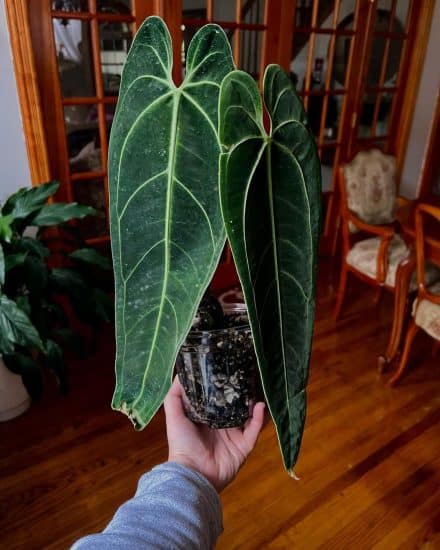
Your Anthurium Warocqueanum is usually pretty resilient, but there are a couple of things you should look out for to keep it happy and healthy.
So let’s talk about those pesky pests and diseases that might pop up and how to deal with them like a pro!
Spider Mites
Anthuriums aren’t your typical pest magnet or anything, but every now and then, those sneaky spider mites might find their way onto your beloved plant. It’s not that they’re especially attracted to Anthuriums, but they often hitch a ride from the nursery or garden center with your other plants.
Spider mites are super tiny (think itty-bitty), so you might not see them right away. But don’t worry, they’ll leave some clues! Keep an eye out for tiny webs on your Anthurium’s leaves and stems, as well as small yellow or brown spots on the foliage.
First, give your plant some space — move it away from your other green babies to stop the mites from moving in elsewhere. Next, use a damp cloth to gently wipe the leaves and stems, removing any webs, mites, and eggs in the process.
Treat your plant with a mix of water and some mild dish soap or neem oil. Make sure you spray both the tops and bottoms of the leaves and keep at it every two weeks until the problem is gone.
To keep those pesky mites from crashing the Anthurium warocqueanum party, check your plant regularly for any signs of unwanted guests. Keep things clean and tidy by getting rid of dead leaves and debris, and make sure there’s good airflow around your plants.
Also, avoid direct light that could stress the plants. And here’s a tip: spider mites hate humidity, so try keeping the area around your Anthurium a bit more humid to deter them.
Root Rot
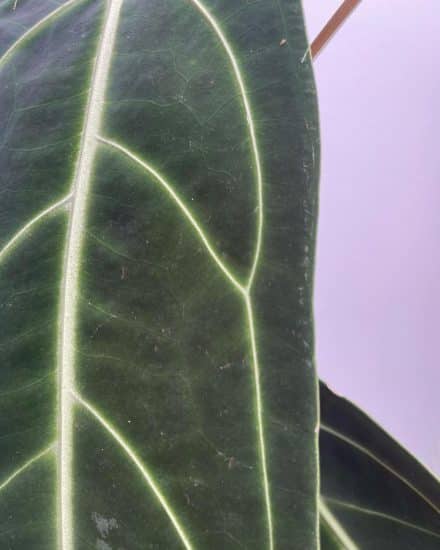
If you notice your Anthurium’s leaves going yellow, wilting, or dropping off (and it’s not just because they’re old), it’s time to investigate root rot.
Carefully take the plant out of its pot and have a look at the roots. If they’re brown or black, mushy, and smelling less than pleasant… you’ve got rot on your hands.
You’re going to want to trim off any affected roots with sterilized shears. Repot in well-draining soil and make sure that you’re using a pot with plenty of drainage.
Moving forward, really cut back on the watering and try to keep air circulation a bit higher to allow that soil to dry off.
Conclusion
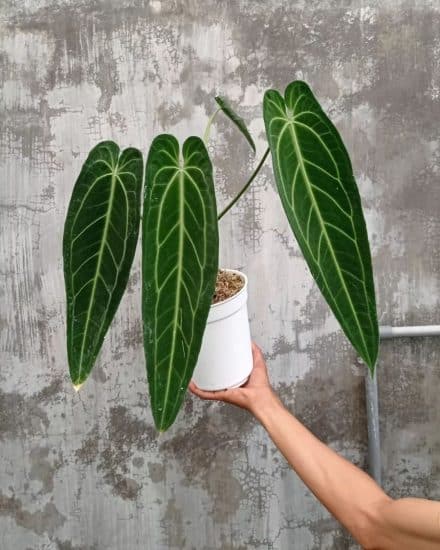
That’s it for our Queen Anthurium care guide! With a bit of extra attention and the right conditions, you’ll soon find yourself feeling like plant royalty as you nurture this stunning tropical beauty.
Anthurium warocqueanum care tips:
- Keep humidity as high as possible. For this, you’ll likely need all the tools you have. A humidity monitor, pebble tray (or two), grouping your plants together, and adding a tiny humidifier if you’re in an especially dry climate. 50-60% humidity is ideal, but it can really tolerate up to 90%.
- These tropical plants like medium indirect light. Try to calibrate your watering frequency and fertilizer use with how quickly they’re growing.
- Consider adding orchid bark (epiphytes love it!) or peat moss to your potting mix to keep it well-draining, moisture-retaining, and full of nutrients.
These plants are pretty rare and expensive, so we understand wanting to get care just right. The stakes are so high, so we hope this guide has been helpful. Remember to be patient, stay observant, and embrace the challenge of caring for this regal beauty.
If you have any questions or need extra guidance, don’t hesitate to reach out to us!
Take care, and long live the Queen Anthurium!
FAQ
Why is Anthurium warocqueanum so expensive?
Queen anthurium’s price is mostly due to demand and growth time. As a tropical plant, Queen Anthurium does grow pretty quickly, especially in a greenhouse environment, but it’s become a trend-setter lately, and it seems like everyone wants one.
As demand slows down and propagation picks up from secondary owners, you’ll likely see prices deflate a bit over time.

